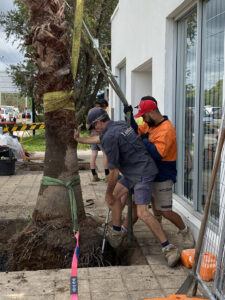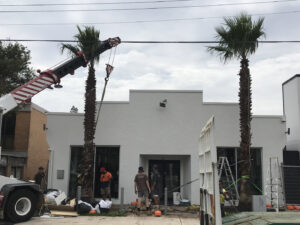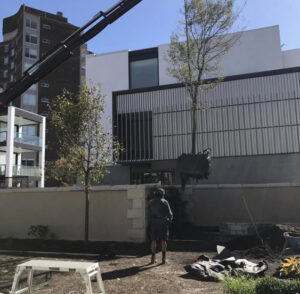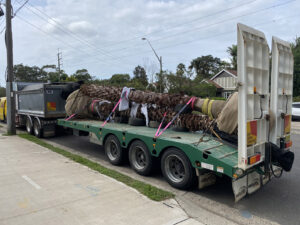Advanced trees: Some tips for budding landscape designers
By Gabrielle Stannus
Well-known designer, Matt Leacy, is a regular media commentator and column writer. Recent TV presenting roles have seen him as Channel 10’s Landscaper to ‘The Living Room’, and Channel Nine’s ‘Domestic Blitz’ and ‘Garden Gurus’. He regularly features on ABC TV’s Dream Gardens, as well as on Channel 10’s Studio 10 and Channel Nine’s The Today Show. Here Matt provides some words of wisdom to budding designers thinking about using advanced trees in their landscape designs.
Co-founder of Manly and Byron Bay based Landart, and a qualified structural landscaper and horticulturist, Matt is well-versed in the installation of advanced trees having more than 20 years’ experience in landscape design, construction, and maintenance across residential and commercial properties. Matt acknowledges that not all clients have the budget to be able to afford advanced trees. However, for those who can, he says advanced trees can create instant privacy and screening, add value to a property, and provide immediate presence and the ‘wow factor’. “All my clients, when the big stock starts coming in, say that is the one thing they are more excited about than building the house,” says Matt, “You know, it is like ‘Oh my God, the trees are coming in!’ That is such an awesome thing to hear as a designer.”

Matt says that purchasing an advanced tree may even help you reduce your plant costs, He explains that the saving on the big tree by buying smaller stock at the outset might cost you down the track. “If you initially plant a small tree and underplant it with understory planting, as that tree grows, the plants that are growing underneath it will likely need replacing as the aspect changes,” says Matt. The smaller plants may go from being positioned in full sun to full shade and depending on what you are planting, may have to be replaced as the tree establishes itself.
Maximise vantage points
Given the cost of advanced trees, and with space at a premium these days, Matt says that designers must ensure that they select the right tree for the right aspect and space. “Look for opportunities to put that tree in that place where people will really get a kick out of seeing it,” says Matt, “Strategically place that tree to suit a key area, like shade for a sitting area or a line of sight, e.g., a central point to a window, door or pathway where your clients can receive the most benefit from it.”
Purchase quality stock from reputable nurseries
“When you buy an established plant, you are buying time,” says Matt, “You are paying the nursery for years of their time to grow this plant.” Matt therefore encourages designers to find a trusted large tree grower and work closely with them. “We have used a lot of different people over the years,” Matt continues, “Those suppliers that can get you things at a really good price are often not doing their due diligence on taking care of that tree.”

Matt recommends that designers purchase stock that meets Australian Standard (AS) 2303:2018 Tree Stock for Landscape Use. “It is a risky business, transplanting big trees, and if stock turns up and it is not quite what it was supposed to be, the cost to put another one in if it went wrong, can be huge. If you are at the back end of a property and you have completed the rest of the landscape, then to get another tree in there, you are going to destroy things that you have already put in place or plants that have grown on,” Matt explains.
Consider planting palms
Working in Sydney’s beachside suburbs, many of Matt’s clients seek a relaxed, exotic vibe. “Palms tie in with the coastal aesthetic nicely. And depending on what type of palm you are going for, will determine their overall cost,” says Matt. Whilst not technically ‘trees’ (they are arborescent monocots), Matt says that using advanced palms can be an excellent way to bring scale into the garden, and he has used Howea forsteriana (Kentia Palm), Livistona australis (Cabbage-tree Palm) and Washingtonia filifera (California Fan Palm) in recent designs.

Do not palm off the trees just yet!
“It is more fun putting in a big tree than a big palm because there is just something really cool about floating a massive tree into a backyard,” Matt laughs. However, jokes aside, putting advanced trees into a property can bring many more benefits than just a smile to your landscape designer’s face! Installing an advanced tree in a garden or landscape can create an instant microclimate. Deciduous trees can provide summer shade (and coolth) whilst allowing winter light in, whilst evergreen trees can provide protection from wind. “In years gone by, we were planting a lot of large deciduous and evergreen trees,” says Matt. More recently, he and his team have used Ulmus parvifolia (Chinese Elm), Pyrus nivalis (Snow Pear) and Betula nigra (Tropical Birch) in their designs.
Install drainage
“Palms are a little bit more forgiving when it comes to water at the base of them, whereas trees can be less forgiving,” says Matt, “If you are working on a sandy site, but have got heavy clays or you are going down into bedrock, the worst thing you can do is create a dish at the bottom of the root ball where water can pool. You need to provide that water with an avenue of escape. Making sure that the drainage is good is the first thing you must do.”

Be prepared to be creative at installation time
Matt and his team have come up with some creative ways of moving big plants into small spaces. “Sometimes we have been unable to crane in advanced trees into their final location. We once had to set up a type of pulley and winch system to wrestle some large Tree Aloes (Aloe barberae) down into a backyard by a pool,” says Matt. Other times, his team have had to move plants into tricky situations in a manner he jokingly refers to as “convict-style”!
Secure your tree into position properly
“If you have a really top-heavy tree, the last thing you want is that tree blowing over,” says Matt. He has used steel bars driven down on an angle through the root ball of palms to tie them into position. “Because the palm possesses a fibrous root system, you are not at risk of damaging it,” Matt explains, “However, if they are tall and you are in a very windy scenario, they can easily move or subside or start to tilt or even blow over. So, it is super important that you make sure you consider how you are going to contain the advanced plant in place whilst it sets its own roots and its own structure. There are a range of root ball anchor systems available to secure advanced trees into position, so be sure to consider these first.”
Forgo irrigation at your peril!
“If you plant a big tree, you need to know how to take care of it because there is a lot riding on that. They cost a lot to purchase and install. The last thing you want is that plant dying,” says Matt, “You need to ensure that it is getting the required water. Do not leave it up to hand watering; set up an irrigation system. It is better off getting more water to begin with than too little. Mulch the tree to retain soil moisture.”
Last but not least … engage a good crane operator
“There is a real skill required in slinging and balancing a tree to get it into position,” says Matt, “You want a crane operator who has worked with trees before and has the patience to do it properly and to do it well.” Matt also recommends craning in multiple objects, including the advanced tree, at the same time. It will minimise the disturbance on your client’s neighbours but also save your client money too!
Gabrielle Stannus
Inwardout Studio
M: 0400 431 277
E: gabrielle@inwardoutstudio.com
Main photo: Washingtonia filifera (California Fan Palm) transported to site on a flatbed truck, before a Franna (taxi) crane was used to get them in and under the overhead wires in the street
(All images: Landart)

